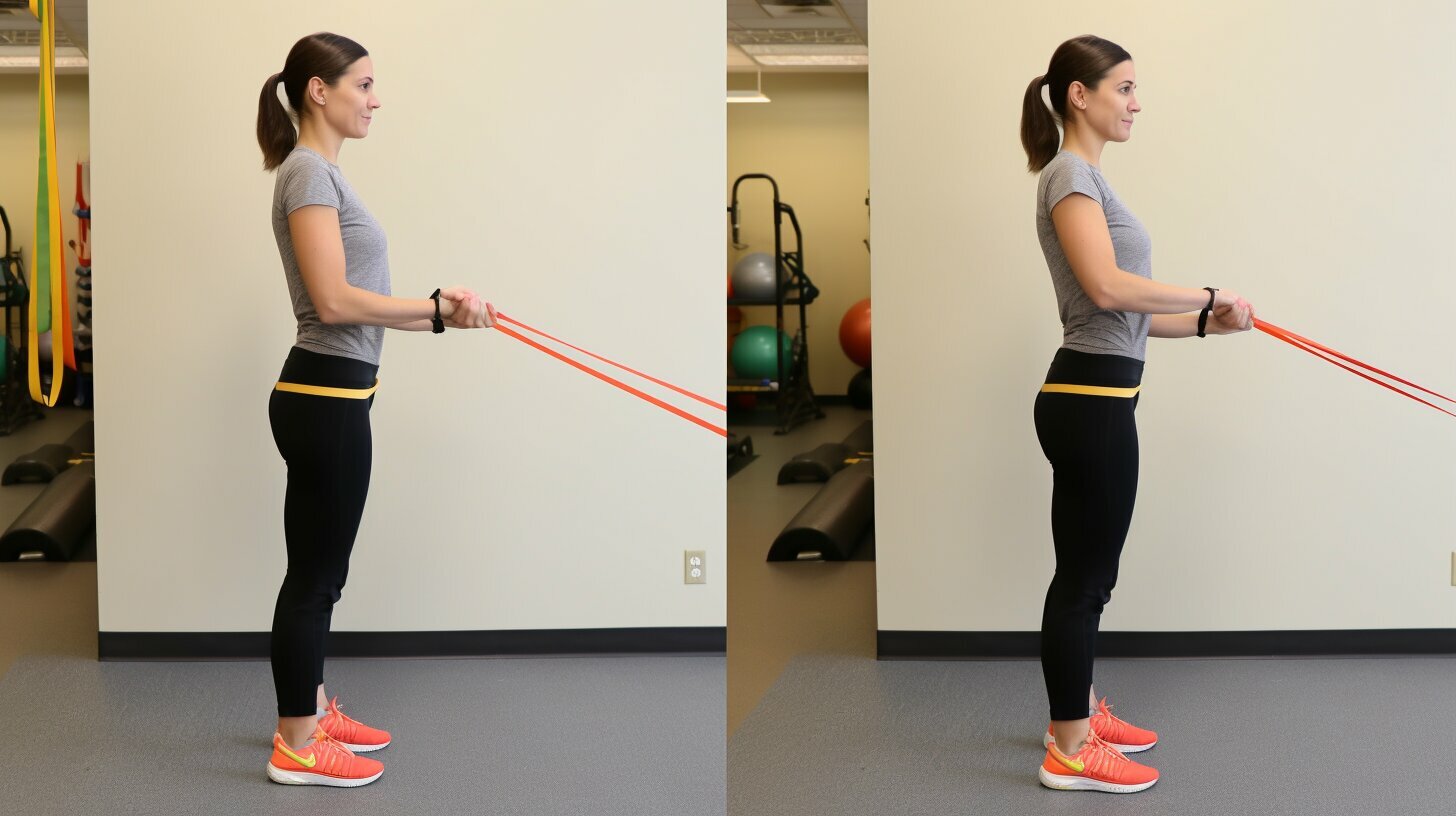Resistance band exercises are a highly effective way to build muscle and can be done anywhere. These versatile bands provide increasing tension as they are stretched, offering a muscle-building stimulus that can challenge individuals of all fitness levels.
Key Takeaways:
- Resistance band exercises are a convenient and effective method for building muscle.
- They provide increasing tension as they are stretched, targeting multiple muscle groups.
- Resistance bands are portable, allowing for workouts anywhere, anytime.
- These exercises can improve the quality of reps, reduce the risk of injury, and add variety to your workouts.
- Choosing the right resistance band for each exercise is crucial for optimal results.
Benefits of Resistance Band Exercises
Resistance band exercises offer a range of benefits, including improving the quality of reps, reducing the risk of injury, and adding variety to your workouts. These exercises provide a muscle-building stimulus by offering increasing tension as the bands are stretched. This constant tension helps to stimulate muscle growth and strength development. Whether you’re a beginner or advanced fitness enthusiast, resistance band exercises can be easily adapted to suit your fitness level.
One of the key advantages of resistance band exercises is their ability to target small muscle groups that are often overlooked in traditional weightlifting routines. By training these smaller muscles, you can improve overall muscle balance and reduce the risk of injury in everyday activities. Resistance bands also allow for a wider range of motion compared to traditional weights, enabling you to work through a greater range of exercises and engage muscles from different angles.
In addition to their effectiveness, resistance bands are cost-effective and portable, making them a convenient option for home workouts or on-the-go training. They are lightweight and easy to pack, allowing you to take your workout anywhere. Whether you’re traveling, at the office, or simply prefer the convenience of home workouts, resistance bands provide a versatile and compact solution for muscle building.
Improving Form and Adding Variety
Another benefit of resistance band exercises is their ability to improve form and technique. The constant tension provided by the bands helps to stabilize and control movements, promoting proper alignment and muscle activation. This can be particularly beneficial for beginners or those recovering from injuries, as it allows for safer and more effective workouts.
Furthermore, resistance bands offer a wide range of exercise options, allowing you to add variety to your workouts and prevent boredom. From upper body exercises like resistance band biceps curls and overhead triceps extensions to lower body exercises like Spanish squats and banded hamstring curls, there are countless exercises you can incorporate into your routine. The versatility of resistance bands makes it easy to target specific muscle groups or create full-body workouts that engage multiple muscles simultaneously.
With their numerous benefits and versatility, resistance band exercises are a valuable addition to any fitness routine. Whether you’re looking to build muscle, improve form, or add variety to your workouts, resistance bands provide a convenient and effective solution. So grab a resistance band, give these exercises a try, and experience the benefits for yourself.
| Resistance Band Exercise | Targeted Muscle Group |
|---|---|
| Chaos Push-Ups | Chest, shoulders, triceps |
| Bent-Over Rear Delt Flye | Rear delts, upper back |
| Spanish Squat | Quadriceps, glutes |
| Half-Kneeling Band Row | Back, biceps |
| Band Thruster | Legs, shoulders |
| Band-Assisted Broad Jump | Legs, explosiveness |
| Resistance Band Biceps Curl | Biceps |
| Overhead Triceps Extensions | Triceps |
| Band-Resisted Push-Up | Chest, triceps, shoulders |
| Band X Crossover Lateral Walk | Hips, glutes, abductors |
| Band-Assisted Chin-Up | Back, biceps |
| Banded Passive Leg Lower | Hamstrings, glutes |
| Band Tall-Kneeling Pull-Apart | Shoulders, upper back |
| Banded Hamstring Curl | Hamstrings |
Choosing the Right Resistance Band
Not all resistance bands are created equal, so it’s important to choose the right band for each exercise. The right resistance band can ensure that you are effectively working your muscles and getting the most out of your workout. When selecting a resistance band, consider the following:
- Resistance Level: Resistance bands come in different levels of tension, usually categorized by color or resistance level. It’s important to choose a band with a level of resistance that challenges you without being too easy or too difficult. Start with a lighter resistance if you’re a beginner and gradually increase as you get stronger.
- Material and Durability: Resistance bands are typically made of latex or fabric. Latex bands tend to be more durable and provide a greater range of resistance, while fabric bands are often more comfortable and suitable for people with latex allergies. Consider your preferences and needs when selecting the material.
- Length and Size: The length and size of the resistance band can affect the exercises you can perform. Longer bands allow for more versatility and greater range of motion, while shorter bands may be more suitable for targeted exercises. Consider the exercises you plan to do and choose a band that accommodates your needs.
By considering these factors, you can find the right resistance band that suits your fitness level, preferences, and goals. Remember that investing in high-quality resistance bands can make a significant difference in the effectiveness and longevity of your workouts.
Importance of Choosing the Right Band
“Using the correct resistance band for each exercise is essential to target specific muscles and optimize your workout.” – Fitness Expert
Choosing the right resistance band is not just about finding the appropriate level of resistance. It’s also about ensuring that you are engaging the right muscles and getting the most out of each exercise. Using a band that is too loose or too tight can result in ineffective workouts and even potential injury.
When you choose the right resistance band, you can effectively target the muscle groups you want to work on and create the desired muscle-building stimulus. Additionally, the right band can help you maintain proper form throughout your exercises, reducing the risk of strain or injury.
Take the time to research and explore different resistance bands available in the market. Read reviews, consult with fitness professionals, and try out different bands to find the ones that work best for you. Remember, selecting the right resistance band is a crucial step towards maximizing the benefits of your resistance band exercises.
| Resistance Level | Material and Durability | Length and Size |
|---|---|---|
| Light | Latex | Longer |
| Medium | Fabric | Shorter |
| Heavy |
Resistance Band Exercises for Arms
If you’re looking to tone and strengthen your arms, there are several resistance band exercises that can help you achieve your goals. Resistance bands provide a versatile and effective way to target the muscles in your arms, including the biceps, triceps, and shoulders.
One popular resistance band exercise for the arms is the resistance band biceps curl. To perform this exercise, stand on the resistance band with your feet shoulder-width apart, holding the band handles in each hand. Keep your elbows close to your sides and slowly curl your hands upwards towards your shoulders, contracting your biceps. Lower the bands back down to the starting position and repeat for the desired number of repetitions.
Another effective exercise for the arms is the overhead triceps extensions. Begin by standing on the resistance band with one foot and hold the band handle with both hands, raising it overhead. Keep your elbows close to your ears and slowly lower the band behind your head, feeling the stretch in your triceps. Raise the band back up to the starting position and repeat the movement.
By incorporating resistance band exercises like the resistance band biceps curl and overhead triceps extensions into your routine, you can effectively target and strengthen your arm muscles. Remember to start with a resistance band that provides an appropriate level of resistance for your fitness level and gradually increase the tension as you become stronger. With consistent effort and proper form, you’ll be on your way to achieving toned and stronger arms.
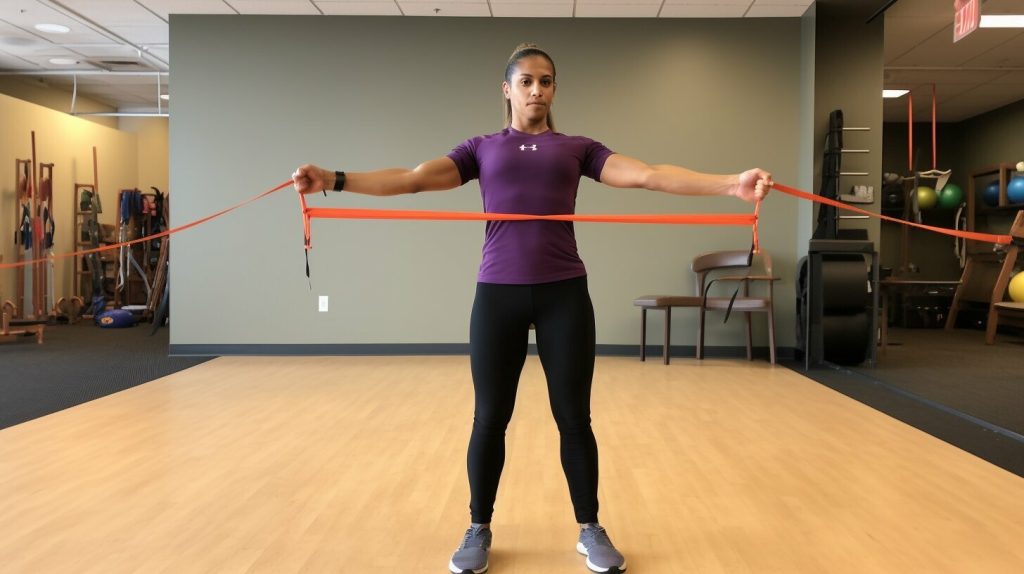
| Resistance Band Exercise | Muscles Targeted |
|---|---|
| Resistance Band Biceps Curl | Biceps |
| Overhead Triceps Extensions | Triceps |
Resistance Band Exercises for Legs
Building strong and toned legs is possible with resistance band exercises that specifically target the leg muscles. Resistance bands provide an effective way to add resistance to your leg workouts, helping you build strength and definition. Whether you’re a beginner or an experienced athlete, incorporating resistance band exercises into your leg routine can take your fitness to the next level.
One of the key resistance band exercises for legs is the Spanish squat. This exercise targets your quadriceps, hamstrings, and glutes. To perform a Spanish squat, place the resistance band around your legs, just above your knees. Stand with your feet shoulder-width apart and toes slightly turned out. Keeping your chest lifted and core engaged, slowly lower into a squat position while pushing against the resistance of the band. Pause at the bottom, then push through your heels to return to the starting position.
Another effective exercise for the leg muscles is the banded passive leg lower. This exercise primarily targets your hamstrings. Begin by lying on your back with the resistance band looped around your feet. Lift your legs up towards the ceiling, keeping them straight. Slowly lower one leg down towards the ground, feeling the resistance of the band. Keep your core engaged and your other leg pointing towards the ceiling. Raise the lowered leg back up to the starting position, then repeat on the other side.
For targeting your hamstrings, the banded hamstring curl is an excellent choice. With the resistance band looped around your ankles, start by standing tall with your feet hip-width apart. Balance your weight on one leg, then lift the other leg behind you while bending your knee and bringing your heel towards your glutes. Slowly lower the raised leg back down, feeling the resistance of the band. Repeat on the other side to work both legs equally.
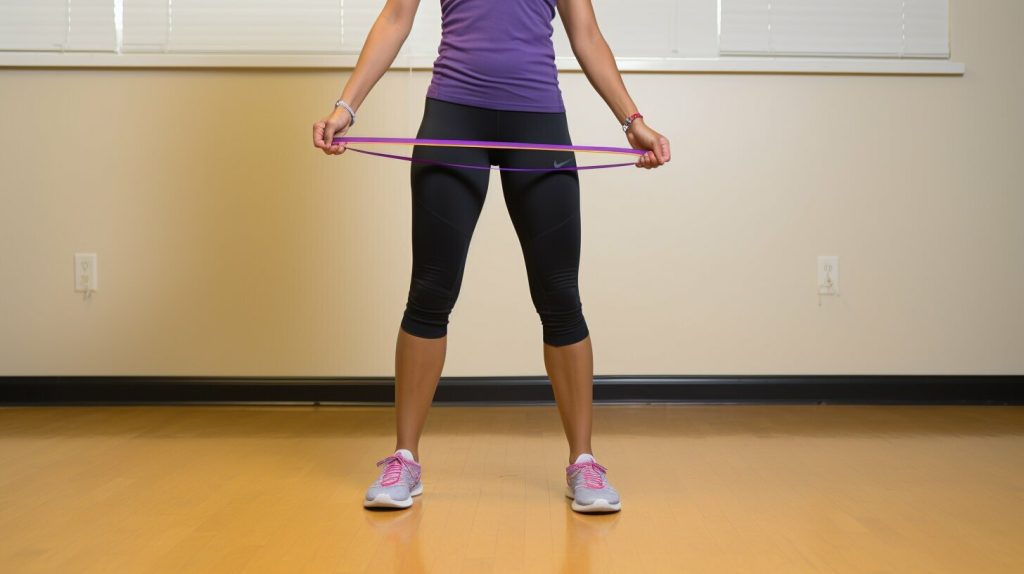
| Exercise | Muscle Group |
|---|---|
| Spanish squat | Quadriceps, Hamstrings, Glutes |
| Banded passive leg lower | Hamstrings |
| Banded hamstring curl | Hamstrings |
Remember, resistance band exercises can be modified to suit different fitness levels. You can increase or decrease the tension of the band to make the exercises more challenging or easier, depending on your strength and ability. Be sure to maintain proper form throughout each exercise to maximize the effectiveness and minimize the risk of injury. With consistent practice and dedication, resistance band exercises for legs can help you achieve your fitness goals and strengthen your lower body.
Full-Body Resistance Band Workout
For a full-body workout using resistance bands, try incorporating exercises that target multiple muscle groups simultaneously. This type of workout is not only efficient but also effective in building overall strength and muscle tone. One of the key benefits of resistance band exercises is their ability to provide increasing tension as they’re stretched, resulting in a muscle-building stimulus. In addition, resistance bands offer a wide range of exercises that can be adjusted to suit different fitness levels.
A full-body resistance band workout can include exercises such as the band thruster and band-assisted broad jump. The band thruster is a compound exercise that targets the lower body and upper body simultaneously. Start by standing on the resistance band with your feet shoulder-width apart, holding the handles at shoulder height. Squat down, then drive through your heels to stand up while simultaneously pressing the handles overhead.
The band-assisted broad jump is another compound exercise that engages the muscles in the lower body. Start by attaching the resistance band around your waist and standing with your feet hip-width apart. Squat down, then explosively jump forward as far as you can while maintaining control. The resistance band will provide additional resistance, challenging your muscles to work harder.
Incorporate other resistance band exercises into your full-body workout to target different muscle groups. The bent-over rear delt flye and half-kneeling band row are great exercises for your back and shoulders.
The bent-over rear delt flye targets the posterior deltoids, which are important for shoulder stability. Stand on the resistance band with your feet hip-width apart, holding the handles with your arms extended in front of your body. Hinge forward at the hips, keeping your back flat, and raise your arms out to the sides, squeezing your shoulder blades together.
The half-kneeling band row targets the muscles in your upper back. Kneel on one knee with the resistance band anchored in front of you. Hold the handles with your arms extended, then pull the band towards your chest, squeezing your shoulder blades together.
| Exercise | Muscle Group |
|---|---|
| Band Thruster | Lower Body, Upper Body |
| Band-Assisted Broad Jump | Lower Body |
| Bent-Over Rear Delt Flye | Back, Shoulders |
| Half-Kneeling Band Row | Upper Back |
Remember to adjust the resistance band tension to suit your fitness level. As you progress and build strength, you can increase the resistance by using a heavier band or shortening the band length. Always focus on maintaining proper form throughout the exercises to maximize their effectiveness and reduce the risk of injury. With consistency and dedication, a full-body resistance band workout can help you achieve your fitness goals and build a strong, toned physique.
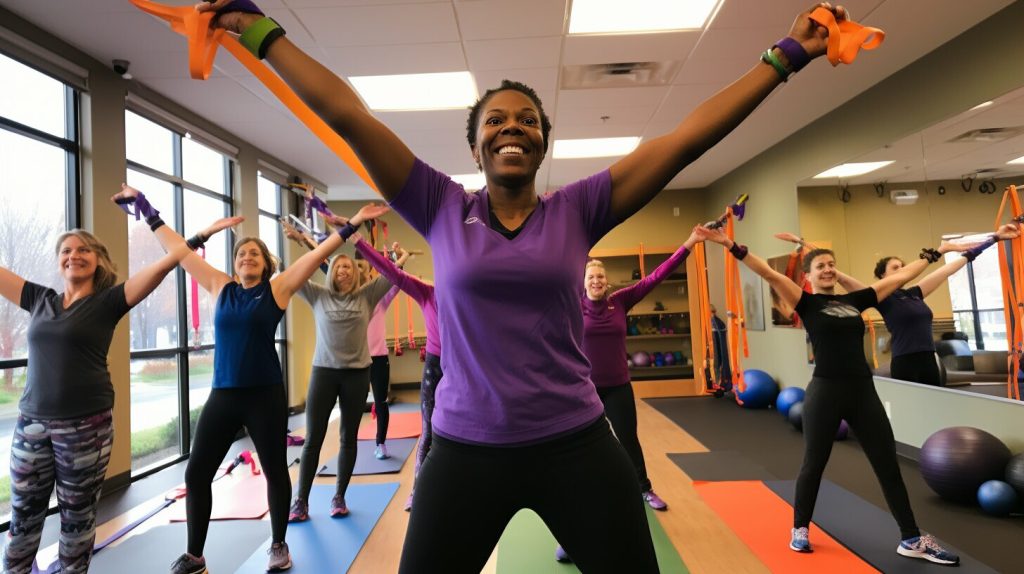
If you’re new to resistance band exercises, there are plenty of beginner-friendly options to get you started on your fitness journey. Resistance bands are a versatile and effective tool for building strength and toning muscles, and they can be used by individuals of all fitness levels. Incorporating resistance band exercises into your routine can help you develop a strong foundation and gradually progress towards more challenging workouts.
One of the key benefits of resistance band exercises for beginners is the ability to improve the quality of reps. The bands provide increasing tension as they’re stretched, which means that you can adjust the resistance based on your current strength level. This allows you to perform exercises with proper form and control, reducing the risk of injury and ensuring that you’re targeting the intended muscle groups.
Resistance bands also offer a wide variety of exercises that specifically target small muscle groups. These exercises help to strengthen and stabilize the muscles that are often overlooked in traditional weightlifting workouts. By incorporating resistance band exercises for beginners into your routine, you can ensure that you’re engaging all of your muscles and developing a balanced physique.
In addition to being beginner-friendly, resistance band exercises are also cost-effective and portable. Unlike bulky weightlifting equipment, resistance bands are lightweight and easy to carry, allowing you to work out anywhere, whether at home or on the go. They’re a convenient option for individuals with limited space or those who prefer to exercise in the comfort of their own homes.
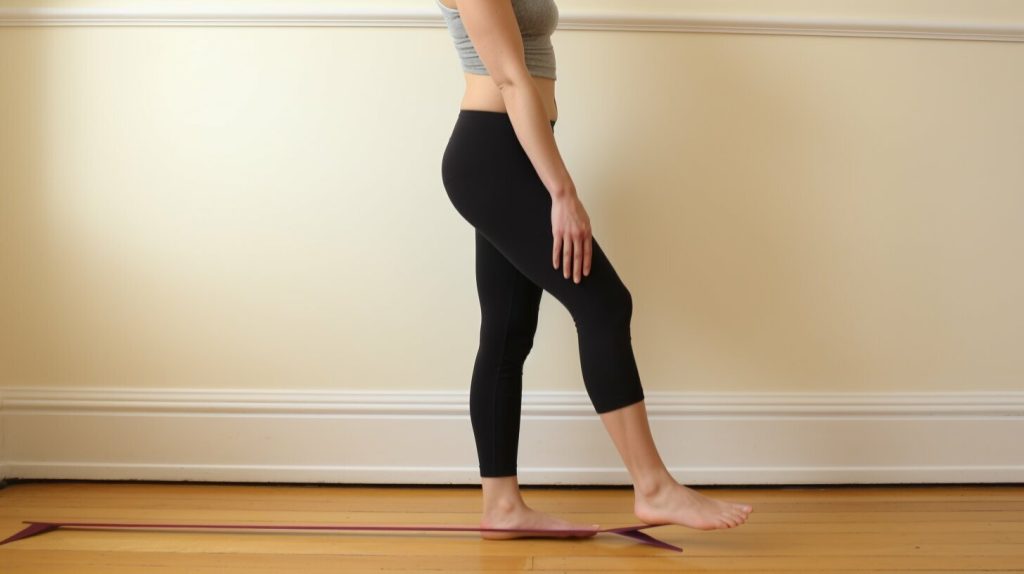
| Resistance Band Exercises for Beginners | |
|---|---|
| Exercise | Targeted Muscle Groups |
| Resistance Band Biceps Curl | Biceps |
| Overhead Triceps Extensions | Triceps |
| Spanish Squat | Quadriceps, Glutes |
| Half-Kneeling Band Row | Back, Biceps |
| Band Thruster | Legs, Shoulders |
| Band-Assisted Broad Jump | Legs, Core |
| Banded Passive Leg Lower | Hamstrings |
| Resistance Band Supermans | Back, Glutes |
These resistance band exercises for beginners are just a starting point. As you become more comfortable and build strength, you can gradually increase the resistance and try more advanced variations. Remember to always listen to your body and work within your limits. With consistency and dedication, resistance band exercises can help you achieve your fitness goals and enjoy the benefits of a stronger, more toned physique.
Resistance Band Exercises for Strength Training
Resistance band exercises are not just for toning, they can also be an effective tool for strength training. These versatile bands provide increasing tension as they are stretched, creating resistance that can challenge your muscles and promote strength gains. Whether you’re a beginner or a seasoned fitness enthusiast, incorporating resistance band exercises into your routine can help you build strength and achieve your fitness goals.
One of the key benefits of using resistance bands for strength training is that they allow you to improve the quality of your reps. Unlike traditional weights, resistance bands maintain tension throughout the entire range of motion, forcing your muscles to work harder. This constant tension stimulates muscle growth and helps you develop strength and power.
Resistance band exercises also have the advantage of reducing the risk of injury. The controlled resistance provided by the bands allows you to perform exercises with proper form, minimizing the strain on your joints and reducing the likelihood of injury. Additionally, resistance bands offer a variety of options for training small muscle groups that are often overlooked in traditional strength-training exercises. By incorporating resistance band exercises into your routine, you can target these muscles and improve overall muscle balance.

Importance of Proper Form
When performing resistance band exercises, it’s crucial to prioritize proper form to maximize muscle engagement and minimize the risk of injury. Using the correct form ensures that the targeted muscles are effectively activated, leading to greater muscle growth and strength development. Additionally, proper form helps maintain joint stability and reduces the strain on surrounding muscles.
Key Tips for Maintaining Proper Form:
- Focus on the muscle you are targeting: Visualize the muscle group you are working and concentrate on contracting and engaging those specific muscles throughout the exercise.
- Control your movements: Perform each exercise with slow and controlled movements, avoiding any jerking or swinging motions. This ensures that the muscles are doing the work, rather than relying on momentum or other muscles.
- Breathe properly: Breathe out during the exertion phase of the exercise, and breathe in during the relaxation phase. This helps maintain oxygen flow and stability during the movement.
- Start with lighter resistance: It’s important to start with a resistance band that allows you to maintain proper form throughout the entire range of motion. Gradually increase the resistance as you build strength and progress.
- Seek guidance: If you’re new to resistance band exercises or unsure about proper form, consider consulting with a fitness professional or watching instructional videos to ensure you’re performing the exercises correctly.
By prioritizing proper form in your resistance band workouts, you’ll not only enhance the effectiveness of your exercises but also reduce the risk of strain, injury, and imbalanced muscle development. Remember, quality and technique are key when it comes to maximizing the benefits of resistance band exercises.
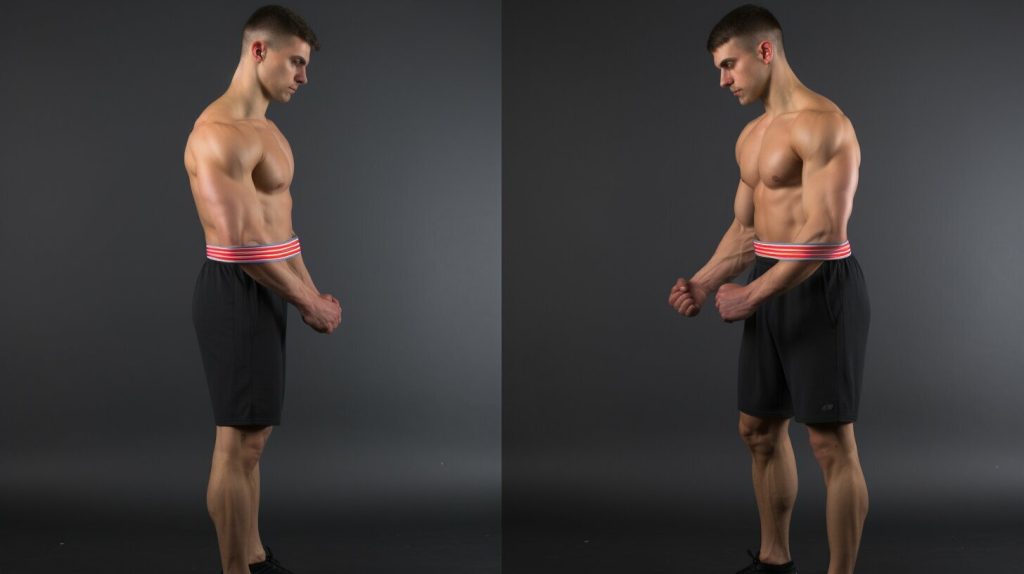
To make the most of your resistance band workouts, follow these helpful tips for a successful session. Resistance band exercises are a versatile and effective way to build muscle and improve overall fitness. Whether you’re a beginner or an experienced fitness enthusiast, these tips will help you maximize your results and prevent injury.
1. Choose the Right Resistance Band: Not all resistance bands are created equal. It’s important to select a band with the appropriate resistance level for each exercise. Start with a lighter band if you’re a beginner, and gradually increase the resistance as your strength improves. Experiment with different bands to find the right level of tension for your workouts.
2. Focus on Proper Form: Proper form is crucial when performing resistance band exercises. It ensures that you’re targeting the right muscles and reduces the risk of injury. Pay attention to your posture, keep your movements controlled, and engage your core throughout the exercises. If you’re unsure about the correct form, consider working with a qualified trainer or watching instructional videos to learn the proper technique.
3. Vary Your Routine: One of the great advantages of resistance band workouts is that they offer a wide variety of exercises. Don’t get stuck in a rut by doing the same routine every time. Mix things up by incorporating different exercises that target different muscle groups. This will not only challenge your body in new ways but also keep your workouts interesting and enjoyable.
| Exercise | Targeted Muscle Group |
|---|---|
| Chaos Push-Up | Chest, shoulders, triceps |
| Bent-Over Rear Delt Flye | Rear delts, upper back |
| Spanish Squat | Quads, glutes, hamstrings |
| Half-Kneeling Band Row | Back, biceps |
| Band Thruster | Legs, shoulders, triceps |
| Band-Assisted Broad Jump | Legs, glutes |
| Resistance Band Biceps Curl | Biceps |
| Overhead Triceps Extensions | Triceps |
| Band-Resisted Push-Up | Chest, shoulders, triceps |
| Band X Crossover Lateral Walk | Hips, glutes, thighs |
By incorporating these tips into your resistance band workouts, you’ll be able to challenge your muscles, improve your strength and flexibility, and achieve your fitness goals. Remember to listen to your body, adjust the resistance as necessary, and have fun while working out. Stay consistent and dedicated, and you’ll see the results you desire.

Disclaimer: Always consult with a qualified fitness professional or healthcare provider before starting any new exercise program or making changes to your current routine.
A Guide to Resistance Band Exercises (Include Specific Exercises)
Ready to dive into some resistance band exercises? Here’s a guide to get you started with specific exercises targeting different muscle groups.
Upper Body
For a challenging upper body workout, try the chaos push-up. This exercise engages the chest, shoulders, and triceps, while also improving stability and coordination. Start in a push-up position with the resistance band looped around your back. Hold one end of the band in each hand and perform a push-up while maintaining tension in the band. Another great exercise for the posterior deltoids is the bent-over rear delt flye. Stand on the band with your feet hip-width apart and grasp the handles. Bend forward at the hips, keeping your back straight, and lift the band out to the sides, squeezing your shoulder blades together at the top of the movement.
Lower Body
To target your lower body, try the Spanish squat. Step on the resistance band with your feet hip-width apart and hold the handles at shoulder height. Squat down, keeping your chest lifted, and then stand back up, pressing through your heels. This exercise works your quadriceps, hamstrings, and glutes. Another effective exercise for the lower body is the half-kneeling band row. Attach the band to a stable anchor point and kneel down in front of it, holding the band with one hand. Pull the band towards your body, engaging your back muscles, and then return to the starting position.
Full Body
If you’re looking for a full-body challenge, try the band thruster. Step on the band with your feet shoulder-width apart and hold the handles at shoulder height. Squat down, keeping your chest lifted, and then explosively push through your heels as you stand up, pressing the band overhead. Lower the band back down to shoulder height and repeat the movement. Another full-body exercise is the band-assisted broad jump. Loop the band around your waist and anchor it behind you. Jump forward as far as you can while keeping tension in the band, and then quickly jump back to the starting position.
| Exercise | Targeted Muscle Groups |
|---|---|
| Chaos Push-Up | Chest, Shoulders, Triceps |
| Bent-Over Rear Delt Flye | Posterior Deltoids, Upper Back |
| Spanish Squat | Quadriceps, Hamstrings, Glutes |
| Half-Kneeling Band Row | Back, Biceps |
| Band Thruster | Quadriceps, Shoulders, Triceps |
| Band-Assisted Broad Jump | Legs, Glutes, Core |
These resistance band exercises are just a starting point. Feel free to modify or progress them based on your fitness level and goals. Remember to warm up before each workout and listen to your body to prevent injury. Incorporating resistance band exercises into your fitness routine can help you build muscle and improve overall strength.

Resistance band exercises are a versatile and effective way to build muscle and enhance your fitness journey. Start incorporating these exercises into your routine and experience the benefits for yourself.
Resistance bands provide increasing tension as they’re stretched, offering a muscle-building stimulus that can be adjusted to suit different fitness levels. What makes resistance band exercises particularly valuable is their ability to improve the quality of reps, reduce the risk of injury, and add variety to your workouts.
Whether you’re training small muscle groups or focusing on major muscle groups like arms and legs, resistance bands can target specific areas and help you achieve your muscle-building goals.
Stay ahead of the curve! Dive into our blog for the latest insights on health and technology. Your journey to a smarter, healthier life begins here.
FAQ
Q: Are resistance band exercises effective for building muscle?
A: Yes, resistance band exercises are highly effective for building muscle. They provide increasing tension as they’re stretched, offering a muscle-building stimulus.
Q: What are the benefits of resistance band exercises?
A: Resistance band exercises have several benefits. They improve the quality of reps, reduce the risk of injury, add variety to workouts, train small muscle groups, and improve form.
Q: How do I choose the right resistance band?
A: It’s important to choose the right resistance band for each exercise. Look for bands with appropriate resistance levels and consider your fitness level and goals when selecting a band.
Q: What are some resistance band exercises for arms?
A: Resistance band exercises for arms include bicep curls and overhead triceps extensions.
Q: What are some resistance band exercises for legs?
A: Resistance band exercises for legs include Spanish squats, banded passive leg lowers, and banded hamstring curls.
Q: Can you provide a full-body resistance band workout?
A: Yes, a full-body resistance band workout can include exercises like the band thruster and band-assisted broad jump.
Q: Are there resistance band exercises suitable for beginners?
A: Yes, there are resistance band exercises specifically suited for beginners. Modified versions of various exercises can be performed to accommodate beginners’ fitness levels. Resistance band exercises are suitable for women as well.
Q: Are resistance band exercises effective for strength training?
A: Yes, resistance band exercises can be very effective for strength training. They provide the necessary resistance for strength gains.
Q: How important is proper form during resistance band exercises?
A: Proper form is crucial during resistance band exercises. It ensures optimal muscle engagement and reduces the risk of injury.
Q: Do you have any tips for a successful resistance band workout?
A: Yes, some tips for a successful resistance band workout include warming up, setting goals, varying intensity, and progressing over time.
Q: Can you provide a guide to resistance band exercises?
A: Certainly! A guide to resistance band exercises includes exercises like chaos push-ups, bent-over rear delt flyes, half-kneeling band rows, band-resisted push-ups, band X crossover lateral walks, band-assisted chin-ups, and band tall-kneeling pull-aparts.

